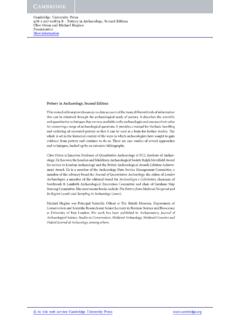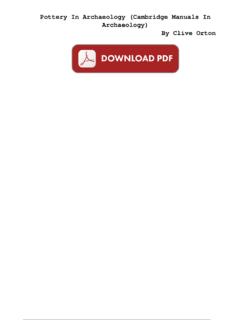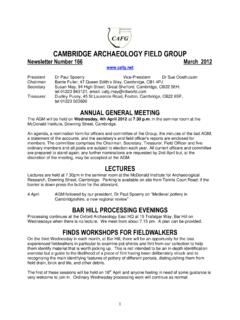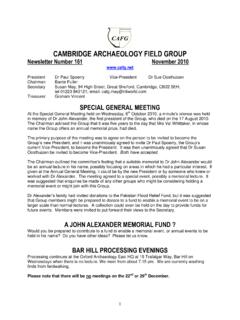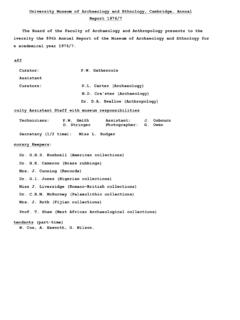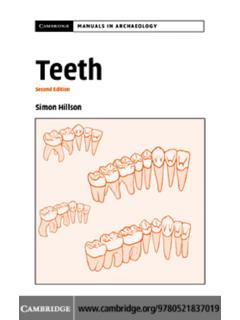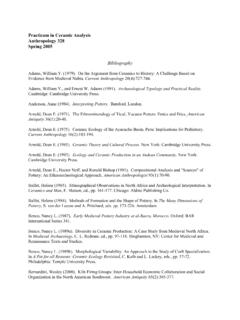Transcription of War Ditches, Cherry Hinton: Revisiting an Iron Age Hillfort
1 Proceedings of the cambridge Antiquarian Society CI ditches is a large enclosure, lying on a spur of the Gog Magog hills to the south of cambridge . Much of this originally circular monument was destroyed by chalk quar-rying in the late 19th to mid 20th centuries, during which time a series of excavations was conducted, largely under the auspices of cambridge Antiquarian Society. Had the monument survived intact, it would undoubtedly have ac-quired scheduled status as one of the county s key prehis-toric monuments.
2 Emergency archaeological work in 2009 was necessitated by ground works relating to the opening of the site to the public as a nature reserve. Excavation of a single large slot through the surviving ditch, in the area most at risk, was supplemented by test pits and auger surveys. Relatively large and well stratified finds and environmental assem-blages were found which, allied with radiocarbon dating, have enabled the first accurate dating of the ditch infill se-quence. It is now clear that the monument was constructed at the end of the 5th century BC or the beginning of the 4th century BC only to be destroyed before completion or shortly thereafter.
3 The site was then abandoned until reoc-cupation in the middle of the 1st century BC. Final infill-ing of the upper part of the ditch probably occurred in the second half of the 1st century the summer of 2008 children playing within the East Pit, Cherry Hinton (Fig. 1, TL 484 555) discov-ered the legs and feet of a human burial, along with animal bones and Romano-British pottery , high up in the south-eastern corner of the quarry. Subsequent visits by members of the cambridge Antiquarian Society (CAS), Oxford archaeology East (OA East) and the parish archaeological warden (Michelle Bullivant) led to the recovery of further finds from the same location.
4 Archaeological deposits along the top of the quarry edge were identified as surviving fills of a remnant of the War ditches . Before this rediscovery the ring ditch was con-sidered to be all but .. quarried away (Evans and Knight 2002, 48). A series of excavations spanning some 70 years had previously taken place, the results being published in the Proceedings of the cambridge Antiquarian Society (PCAS). These are reviewed below in relation to the recent findings. The Wildlife Trust s plans to open the East Pit as a nature reserve entailed significant landscaping at the quarry edge, including the area of the surviving monument.
5 Since the Trust were unaware of the ar-chaeological potential of the site, no provision for ar-chaeological works existed within their budget and funding was therefore agreed with English Heritage for a targeted rescue excavation; this was conducted by Oxford archaeology East between April and June 20 09. This article is designed as a synthesis of the exca-vated findings and is supplemented by the full ana-lytical report which can be freely accessed at History of ExcavationWar ditches lies in a prominent position at c. 46m OD on a spur of the Gog Magog hills, with command-ing views over the Cam valley and into the fens (Fig.)
6 2). It holds an excellent vantage point over much of southern Cambridgeshire, with clear sight-lines to the contemporary Iron Age fort at Wandlebury to the south-east, to the contour fort at Borough Hill, Sawston to the south-west and to Arbury Camp to the north-west. The first record of archaeological discoveries at War ditches , which are located in Figs 3 and 4, came during excavation of the reservoir on Lime Kiln Hill in 1854. The cambridge Chronicle reported the discovery of up to nine skeletons and noted that several of them were of large size, and were evidently the remains of men who reached to a greater height than ordinary men in the present day (Filby 1995).
7 Nearly 40 years later another skeleton was discovered in a new quarry pit opened by Messrs. Crawley and Tebbutt in 1893. This was reported to Professor Thomas McKenny Hughes, a very active member of the CAS who, with the help of Society members, embarked on an archaeological ex-War ditches , Cherry Hinton: Revisiting an Iron Age HillfortAlexandra Pickstone and Richard Mortimerwith Rachel Ballantyne, Barry Bishop, Christopher Bronk Ramsey, Matt Brudenell, Gordon Cook, Nina Crummy, Natasha Dodwell, Chris Faine, Alice Lyons, Peter Marshall, John Meadows and Elizabeth C.
8 Stafford. Illustrations by Gillian GreerProceedings of the cambridge Antiquarian Society CI pp. Pickstone and Richard Mortimer2 Figure 1. Location of War ditches , Cherry Hinton: Revisiting an Iron Age Hillfort3cavation in the area of Tebbutt s Pit . A large ditch was identified, thought at the time to be one of the great East Anglian linear dykes. The name War ditches appears to have originated at this date (Hughes et al. 1894, 319). Although the ditch s function remained un-certain, its infilling was accurately recorded: the ditch got gradually filled up by natural operations during more than one long period, judging by the growth of humus at successive levels, but it must have also been filled in artificially on at least two occasions by throwing back the chalk which had been dug out of it (Hughes et al.)
9 1894, 318; see Figs 3 & 4). During these preliminary excavations, Hughes dis-covered five skeletons, seemingly laid into the ditch (Fig. 5, No. 1). Spurred on by the initial findings it was proposed that the CAS should undertake systematic excavations under the direction of Professor Hughes and with the help of the newly formed cambridge University Digging Club. In a short article Hughes stated Since my last report (Feb. 3) the course of the great fosse has been quite straight, pointing towards the centre of the reservoir, but now it is beginning to curve around to the east.
10 (Hughes 1902a, 234). Continued excavations in the same year confirmed its circular nature and by the time of Hughes sec-ond more lengthy report (1902b) the monument was being compared to the ringworks at Wandlebury and Arbury: We found that the fosse curved stead-ily round as if to pass under the also enabled us to estimate the size and position of our earthwork on the assumption that it was circular, like Ring Hill, Wandlebury and Arbury. This assump-tion proved to be correct, and even with my spud I verified the line of the fosse through Caius Chalk-pit (Hughes 1902b).
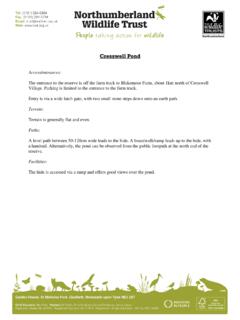
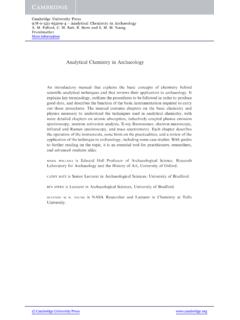
![Handout 1 — Prehistoric Ceramics [11/2015]](/cache/preview/a/e/d/f/3/9/8/7/thumb-aedf398775325961568d0a6b677d6574.jpg)

